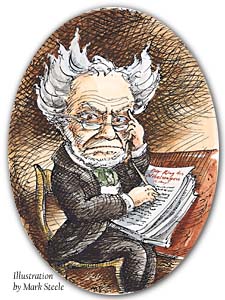Main Menu · Search ·Current Issue ·Contact ·Archives ·Centennial ·Letters to the Editor ·FAQs


Schopenhauer and Wagner--we tend to think of them hand in hand, as Goethe and Schiller are depicted in the monument in Weimar. And why not? Didn't the composer lavishly acknowledge his indebtedness to the philosopher-who supposedly gave his follower his blessing? Yet, how firm is that handshake?
Those of us who hold, with Miss Marple in Murder in the Vicarage, that theory is "so very different from practice, isn't it?" can explore the matter through the single document of an actual "meeting" of the minds of Wagner and Schopenhauer (who in real life never met)-the extensive marginal notes Schopenhauer penciled into a copy of Der Ring des Nibelungen that its author had sent him. This copy, now housed among the treasures of Harvard's Houghton Library, in its hands-on way may tell us more about the relationship of these two giants of cultural life, Teutonic style, than any number of in-depth analyses of their relationship deduced from intellectual history. (I quote the annotations by permission of Houghton Library.)
In his autobiography, Mein Leben, Wagner describes vividly his encounter with Schopenhauer's The World as Will and Representation: "The impact was extraordinary and decisive for the rest of my life." He read the hefty volume four times between the autumn of 1854 and the following summer. Like a revelation, the book  illuminated for him the meaning of his own work. "I looked at my Nibelungen poem," he wrote, "and realized to my own surprise that what was now stupefying me [befangen machte] as theory had long been familiar to me in my own poetic creation. In this manner, I came to understand my own Wotan."
illuminated for him the meaning of his own work. "I looked at my Nibelungen poem," he wrote, "and realized to my own surprise that what was now stupefying me [befangen machte] as theory had long been familiar to me in my own poetic creation. In this manner, I came to understand my own Wotan."
Throughout his theoretical writings, he would invoke the authority of Schopenhauer's understanding of music as the manifestation of "being" in its true essence or essential truth; no other aesthetics of music had, to Wagner's mind, any claim to validity-or was better suited to further Wagner's own cause. Schopenhauer, on the other hand, whose magnum opus had appeared with little notice in 1819, owed his overwhelming upsurge of fame in the second half of the nineteenth century to a considerable extent to the phenomenal ascent of his ardent follower, who incorporated the Weltanschauung of Die Welt als Wille und Vorstellung not only into his musical aesthetics but also into some of his later operas-Tristan und Isolde, Die Meistersinger, and Parsifal.
Schopenhauer confirmed Wagner's own philosophical mood of resignation, which declares everyday reality an illusion; he enlightened Wagner about himself. Wagner stated this unequivocally in letters written at this time; he recommended Schopenhauer to any and all of his friends in the warmest terms and before long had surrounded himself in his Zurich exile with a crowd of Schopenhauer fans. One friend was even dispatched to Frankfurt to visit the notoriously disgruntled sage with an invitation to come to Switzerland to be lionized. Schopenhauer played coy: he no longer traveled, he responded. Undaunted, the Zurich Wagnerians intensified their veneration to the point of promoting the establishment of a professorship of Schopenhauerism at the University of Zurich. Schopenhauer acknowledged that "would be a great honor for me."
The project failed. But that did not dampen the enthusiasm of the Zurich cénacle for the grim old man in Frankfurt-nor Schopenhauer's gratitude for their attention: he had, after all, been chafing for decades at the inattention of the reading public. Yet the beautiful Zurich-Frankfurt relationship wouldn't have been quite the same if Wagner had known how Schopenhauer the reader reacted to the copy of Der Ring des Nibelungen that Wagner had sent him in December 1854 "in veneration and gratitude," as the autograph dedication of the Houghton copy proclaims. Wagner's autobiography discloses a slightly embarrassing secret: Schopenhauer never did send a written reply. Like the good Schopenhauerian that he was, Wagner claimed in Mein Leben that he had "resigned himself" from the outset to the prospect of not receiving a reply. But in fact he did suffer from Schopenhauer's chilling silence; Cosima Wagner's diary records his grief and chagrin as late as March 1878-a generation after the fact.
Still, Wagner did not hold this disappointment against Schopenhauer. His forbearance was made easier by reports from two friends who had visited the philosopher. They told him that Schopenhauer "had made significant and favorable comments on my poem." That the truth was cosmetized more than a little in this formulation is proved by wording reported in Schopenhauer's Conversations. But what the sage of Frankfurt penciled in the margins of his presentation copy of the Ring was even more drastic. For Schopenhauer did look this gift-horse in the mouth, and what he saw didn't please him in the least.
Taking a good look at these marginal notes is not without some voyeuristic thrill. Do they, for example, confirm what we are told in the authoritative Wagner-Handbuch, published in 1986-namely, that the philosopher's comments, no matter how biting, "evidently appreciated the literary rank" of Wagner's ambitious work?
